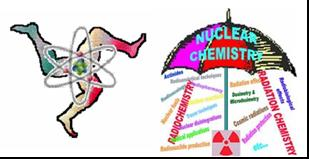Speaker
Dr
Roberto Catalano
(Dipartimento di Fisica e Astronomia -Università degli studi di Catania,INFN sezione di Catania)
Description
Tritium exists rather uniformly in the environment as a result of both natural production by cosmic-ray interaction with the upper layers of the atmosphere and residual fallout from nuclear weapons tests carried out from 1952 till 1980. Naturally occurring tritium mainly reaches the Earth’s surface in the form of precipitation, becoming part of the hydrological cycle. Nowadays, the possibility of measuring the low level of tritium radioactivity gives a chance to use tritium as a natural tracer in the water systems. Surveys has been carried out on Mt. Etna and in the southern side of Nebrodi. The measurements have been carried out by liquid scintillation counting. The samples, collected in natural springs, were prepared according to the International Standard ISO 9698:1989. For each sample 250 mℓ of water were collected. For each one about 250 mg of sodium thiosulfate anhydrous (Na2S2O3) to convert iodine into iodide, and about 500 mg of sodium carbonate anhydrous (Na2CO3) to make the sample alkaline, and some glass beads were added to prevent bumping. Afterwards, the samples were distilled by means of an apparatus consisting of a round bottom flask of capacity 500 mℓ, a Vigreux distillation column, an adapter (bent type) and a condenser. After discarding the first 50-75 mℓ of distillate, about 100 mℓ were collected in polyethylene bottles. With this procedure there was no significant isotopic fractionation in the distillation.
The investigated areas show extremely low tritium concentrations, much below the Italian limit of 100 Bq/ℓ for drinking water and even comparable with the minimum detectable activity value. The effective dose due to tritium consumption is also calculated.
Authors
Dr
Daniela Morelli
(Dipartimento di Fisica e Astronomia -Università degli studi di Catania,INFN sezione di Catania)
Dr
Gabriella Mangano
(Dipartimento di Fisica e Astronomia -Università degli studi di Catania,CSFNSM)
Prof.
Giuseppina Immè
(Dipartimento di Fisica e Astronomia -Università degli studi di Catania,INFN sezione di Catania)
Dr
Roberto Catalano
(Dipartimento di Fisica e Astronomia -Università degli studi di Catania,INFN sezione di Catania)
